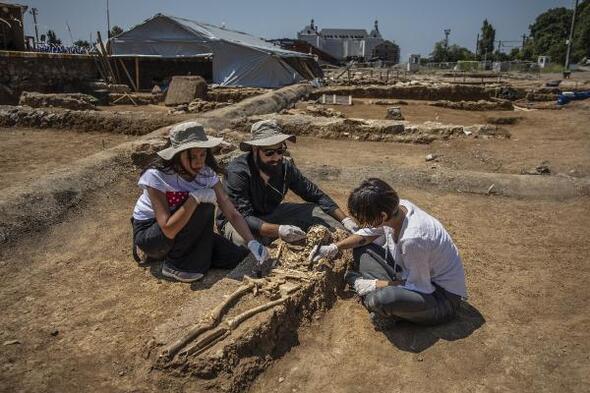Kadıköy’s history resurrected in Haydarpaşa
ISTANBUL

Archaeological excavations have revealed important clues to life in ancient times in Istanbul’s Kadıköy neighborhood, then known as Khalkedon or the “Land of the Blind.”
Archaeologists have unearthed mass graves, the ruins of a fifth century church and about 6,000 coins, among other items, in a 300,000-square-meter excavation area that starts behind Haydarpaşa Railway Station and continues towards İbrahamağa, said Rahmi Asal, director of the Istanbul Archaeological Museum, in an interview with Demirören News Agency. The area includes the harbor in the ancient western port of Khalkedon.
The excavations, under the supervision of the Ministry of Culture and with the support of the Ministry of Transport, began in May 2018 with a team of 400 workers, 17 archaeologists and three museum experts.
The archeological crew encountered a wall structure in the area where the first excavation started, the museum director said.
“It gave us great excitement,” Asal said.
“We first thought that such a large wall would be associated with the ancient harbor. Later, both the construction style and archival research revealed that it was a building belonging to the Ottoman period, and it was built in 1872 and used as a set wall. There is a British cemetery right behind us.”
In an area known as Platform 2, Asal said, archaeologists found a group of buildings starting from the reinforced concrete and stone structures built in the 1960s and dating back to the Hellenistic period.
“We are talking about structures that cut and disrupt each other, not stratification. Most of the buildings here are early Byzantine building groups. However, in the excavation area here, we also encountered a different building group that we anticipated during the first excavation. We estimate that this structure belongs to the Hellenistic period; it is a platform belonging to the fourth century B.C. Just under the platform, there is a column heading belonging to the early Byzantine period,” he said.

Fifth-century church remains
The excavations at Platform 2 also located the ruins of the Sainte-Bassa church-monastery, which has an important place in the Christian world and is marked on different versions of the old Khalkedon city map.
“One of the things that surprises us is that we encounter a burial with bones. Probably these were religiously important people,” Asal said. “Looking at the 26 skulls, we can say that there are 26 burials here. However, when we look at the number of bones, it is estimated that there are more burials.”
Another important excavation area continues in the so-called culverts. Experts think that the area contained quarries and military quarters where soldiers stayed during the 12-year Iranian expedition during the time of Sultan Murat III.
“We also found a plate and a coin, which dated to the period of this sultan. It was an important find for us,” Asal said.
In the İbrahimağa area, where about 6,000 coins were found, Asal said, archaeologists initially thought that it could have been a coin mint but found no additional evidence to support that theory.
















